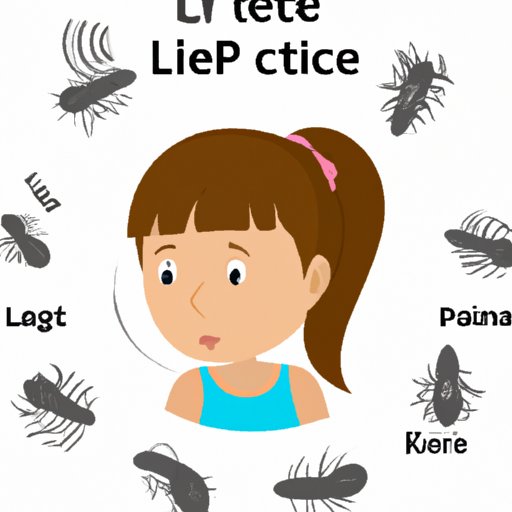
Introduction
If you or your child has been diagnosed with lice, one of the first questions that may come to mind is how long the infestation has been present. Knowing the duration of the infestation can be important when it comes to selecting the most appropriate treatment options and preventing future outbreaks.
Breakdown of the Lice Life Cycle
Before we dive into calculating the duration of a lice infestation, it’s important to understand the lice life cycle. Lice go through three stages: egg, nymph, and adult. Understanding each stage and its duration can help you better conceptualize how long the infestation may have been present.
Egg stage
During the egg stage, lice lay eggs, known as nits, on hair shafts close to the scalp. These eggs typically hatch in 7 to 10 days.
Nymph stage
After the eggs hatch, the lice enter the nymph stage, during which they must feed on blood to grow and molt their exoskeleton. This stage lasts about 7 days.
Adult stage
Once the lice have matured into adults, they can reproduce and continue the infestation. Adult lice can live for up to 30 days if they have a consistent blood supply.
Symptoms and Signs of Infestation
In addition to understanding the lice life cycle, it’s important to know the symptoms and signs of an infestation. These typically include:
Itching
Lice bites can cause itching and irritation on the scalp and other areas with hair, like the neck and shoulders.
Visible eggs or lice
Adult lice or nits may be visible on the scalp, hair, or clothing.
Redness and inflammation
Continual scratching and irritation from lice bites can cause redness and inflammation on the scalp.
Flu-like symptoms
In rare cases, a lice infestation may cause flu-like symptoms such as a fever and swollen lymph nodes.
Mild infestations may have fewer symptoms, while severe infestations may present with additional symptoms and signs. These symptoms can help you estimate the duration of the infestation and the severity of the outbreak.
Methods of Lice Detection
Once you suspect that someone has lice, there are multiple ways to confirm the infestation. These methods include:
Combing through hair
Using a fine-toothed comb designed specifically for lice, you can comb through the scalp and hair to check for nits and live lice. This method is the most reliable for detecting an infestation.
Using a black light
A black light may help detect lice on darker hair by causing them to fluoresce.
Checking for visible eggs or lice
Adult lice or nits may be visible on the scalp, hair, or clothing, making them easy to detect with the naked eye.
Each method has varying effectiveness and detecting an infestation early can be important in treating it quickly and effectively.
Comparison of Infestation Duration to Severity
The duration of a lice infestation can be an indicator of its severity. Mild infestations may have been present for a shorter period of time, while severe infestations may have gone untreated for a longer period of time.
To calculate the duration of a lice infestation, you can estimate the number of nits and how far they are from the scalp. Nits found closer to the scalp mean the infestation is likely more recent than those farther away. Additionally, the presence of adult lice may indicate a longer infestation.
How Often to Check for Lice
Checking for lice at regular intervals can be important in catching infestations early and preventing the spread of lice. You should check for lice if you or your child:
- Has been in contact with someone who has lice
- Experiences itching and irritation on the scalp
- Attends a school or daycare with a history of lice outbreaks
- Shares personal items, such as hats or combs, with others
By checking for lice at these intervals, you may be able to detect an infestation early and prevent the spread of lice to others.
Treating an Infestation
If you or your child has lice, treatment options include over-the-counter medications, prescription medications, and natural remedies.
Over-the-counter treatments typically contain chemicals such as permethrin or pyrethrins and can be applied directly to the scalp and hair to kill the lice and nits. Prescription medications may be recommended if over-the-counter treatments are not effective.
Natural remedies, such as tea tree oil or neem oil, may also be effective in treating lice, though their efficacy has not been clinically proven.
The duration of the infestation may be important in selecting the most appropriate treatment option. Longer infestations may require multiple rounds of treatment or stronger medications.
Preventing Future Infestations
To prevent future infestations, it’s important to practice good personal hygiene habits, clean and disinfect items that may come into contact with lice, and avoid sharing personal items that may harbor lice. Other preventive measures may include:
- Avoiding head-to-head contact with others
- Avoiding trying on clothing in stores
- Washing bedding and clothing on a regular basis
- Vacuuming furniture, carpets, and car seats
Conclusion
Calculating the duration of a lice infestation can be important in selecting the most appropriate treatment options and preventing future outbreaks. By understanding the lice life cycle, symptoms of infestation, detection methods, and prevention strategies, you can take steps to successfully manage lice infestations.
If you suspect that you or your child has lice, be sure to consult with a healthcare provider or lice removal specialist to determine the most appropriate course of action.




